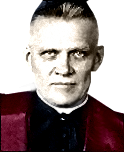Cardinal Theodor Innitzer: “The Heil Hitler Cardinal”

Both Theodore Innitzer and former UN Secretary-General, Kurt Waldheim, remain two of Austria’s most dubious loyal sons. (Unless you include Hitler as well).
Both men were active in the late 1930s in Austrian politics that then leaned heavily towards fascism and its fluctuating local agenda. Both men were paid up members of the controversial Catholic movement “Cartellverband” (CV) and its popularity is still very prominent today. The present pope is a member, as indeed is cardinal Schoenborn who also claims an affiliation.
In the early 1930s archbishop Innitzer, as he was then, served surprisingly as Minister of Social Affairs in the then Austrian Government, definitely a case it seems of church and state working happily together.
But it was in the called political “Anschluss” that Innitzer offered, whole-heartedly, his blind support of its future aims and of foolishly aligning himself and his church to Hitler’s mastery or enslavement of a vulnerable Europe, that events started to change.
Innitzer would also coerce fellow bishops to sanction the plebiscite. Even ordering Nazi flags to fly from country and town churches as well as his own cathedral in Vienna, the imposing St. Stephens. This, of course, brought a swift rebuke from the Vatican Secretary of State, Cardinal Pacelli. And after a summons to Rome, Innitzer had to morally climb down and issue a statement that claimed that the plebiscite was not compatible with God’s law. Whatever that meant!
Eugene Pacelli, as a previous nuncio in Germany for 18 years, certainly knew his way around that murky political minefield. But he was having none of the Austrians sucking up to Hitler-never mind that Pacelli had himself eagerly signed the notorious papal treaty with the Nazis in 1933.
Later it all turned sour for Innitzer, with amongst other things, dangerous riots with Catholic youth and Hitler youth groups fighting each other outside and in the cathedral precinct.
Innitzer would also feel the lash of Hitler’s tongue as well.
Much of this dramatic period can be seen in the 1963 film The Cardinal, with a sterling performance from the Austrian actor, Josef Meinrad, who portrays Innitzer as a willing fool blinded by Hitler’s sweet talk and caught up in the Nazi drama of that time. It’s well worth renting a copy.
By the war’s end in 1945 and for the last ten years of his life, he remained in many Austrians eyes simply as “Hitler’s cardinal.” How sad for him.
He died in 1955 and was succeed by cardinal Franz Koenig.
Today Innitzer lies with the other unsaved cardinals and priests in the crypt of his cathedral. And how sad for all of these men.
On a visit to St. Stephen’s a few years ago, I journeyed down into the vaults for further inspection. I was immediately struck when seeing how small Innitzer’s coffin was. But also of the pervading gloom that was all around. It was damp, cold and very claustrophobic and spooky. You know what? I couldn’t wait to get out!
Update: In her memoirs, Hitler’s secretary, Christa Schroeder, writes that when Hitler met the cardinal in Vienna, in 1938, “Hitler was very impressed by this visit and kept referring to it during our conversation at tea.” So it seems the two men hit it off. However, in Otto Preminger’s 1963 film The Cardinal, Hitler is heard shouting the cardinal down in anger and disgust in one scene concerning this meeting.
Fraulein Schroder was, of course, present with Hitler at this important meeting with the head of the Catholic church in Austria. Otto Preminger, of course, was not, so I can only suggest that it was all-fictional on his behalf.
GPB
December 2006
Updated, September 2012
(All Rights Reserved)